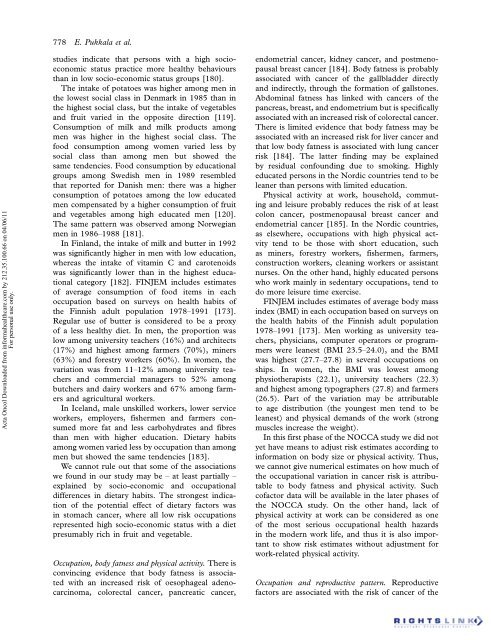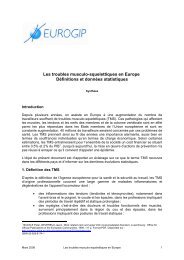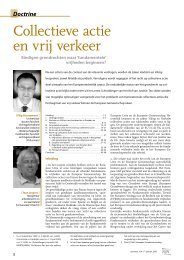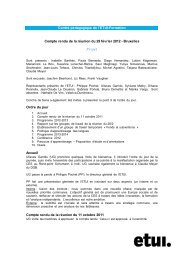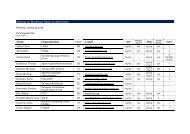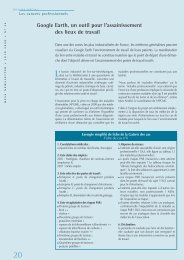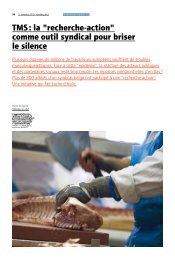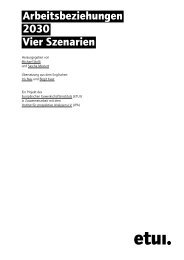Occupation and cancer - European Trade Union Institute (ETUI)
Occupation and cancer - European Trade Union Institute (ETUI)
Occupation and cancer - European Trade Union Institute (ETUI)
You also want an ePaper? Increase the reach of your titles
YUMPU automatically turns print PDFs into web optimized ePapers that Google loves.
Acta Oncol Downloaded from informahealthcare.com by 212.35.100.66 on 04/06/11<br />
For personal use only.<br />
778 E. Pukkala et al.<br />
studies indicate that persons with a high socioeconomic<br />
status practice more healthy behaviours<br />
than in low socio-economic status groups [180].<br />
The intake of potatoes was higher among men in<br />
the lowest social class in Denmark in 1985 than in<br />
the highest social class, but the intake of vegetables<br />
<strong>and</strong> fruit varied in the opposite direction [119].<br />
Consumption of milk <strong>and</strong> milk products among<br />
men was higher in the highest social class. The<br />
food consumption among women varied less by<br />
social class than among men but showed the<br />
same tendencies. Food consumption by educational<br />
groups among Swedish men in 1989 resembled<br />
that reported for Danish men: there was a higher<br />
consumption of potatoes among the low educated<br />
men compensated by a higher consumption of fruit<br />
<strong>and</strong> vegetables among high educated men [120].<br />
The same pattern was observed among Norwegian<br />
men in 1986 1988 [181].<br />
In Finl<strong>and</strong>, the intake of milk <strong>and</strong> butter in 1992<br />
was significantly higher in men with low education,<br />
whereas the intake of vitamin C <strong>and</strong> carotenoids<br />
was significantly lower than in the highest educational<br />
category [182]. FINJEM includes estimates<br />
of average consumption of food items in each<br />
occupation based on surveys on health habits of<br />
the Finnish adult population 1978 1991 [173].<br />
Regular use of butter is considered to be a proxy<br />
of a less healthy diet. In men, the proportion was<br />
low among university teachers (16%) <strong>and</strong> architects<br />
(17%) <strong>and</strong> highest among farmers (70%), miners<br />
(63%) <strong>and</strong> forestry workers (60%). In women, the<br />
variation was from 11 12% among university teachers<br />
<strong>and</strong> commercial managers to 52% among<br />
butchers <strong>and</strong> dairy workers <strong>and</strong> 67% among farmers<br />
<strong>and</strong> agricultural workers.<br />
In Icel<strong>and</strong>, male unskilled workers, lower service<br />
workers, employers, fishermen <strong>and</strong> farmers consumed<br />
more fat <strong>and</strong> less carbohydrates <strong>and</strong> fibres<br />
than men with higher education. Dietary habits<br />
among women varied less by occupation than among<br />
men but showed the same tendencies [183].<br />
We cannot rule out that some of the associations<br />
we found in our study may be at least partially<br />
explained by socio-economic <strong>and</strong> occupational<br />
differences in dietary habits. The strongest indication<br />
of the potential effect of dietary factors was<br />
in stomach <strong>cancer</strong>, where all low risk occupations<br />
represented high socio-economic status with a diet<br />
presumably rich in fruit <strong>and</strong> vegetable.<br />
<strong>Occupation</strong>, body fatness <strong>and</strong> physical activity. There is<br />
convincing evidence that body fatness is associated<br />
with an increased risk of oesophageal adenocarcinoma,<br />
colorectal <strong>cancer</strong>, pancreatic <strong>cancer</strong>,<br />
endometrial <strong>cancer</strong>, kidney <strong>cancer</strong>, <strong>and</strong> postmenopausal<br />
breast <strong>cancer</strong> [184]. Body fatness is probably<br />
associated with <strong>cancer</strong> of the gallbladder directly<br />
<strong>and</strong> indirectly, through the formation of gallstones.<br />
Abdominal fatness has linked with <strong>cancer</strong>s of the<br />
pancreas, breast, <strong>and</strong> endometrium but is specifically<br />
associated with an increased risk of colorectal <strong>cancer</strong>.<br />
There is limited evidence that body fatness may be<br />
associated with an increased risk for liver <strong>cancer</strong> <strong>and</strong><br />
that low body fatness is associated with lung <strong>cancer</strong><br />
risk [184]. The latter finding may be explained<br />
by residual confounding due to smoking. Highly<br />
educated persons in the Nordic countries tend to be<br />
leaner than persons with limited education.<br />
Physical activity at work, household, commuting<br />
<strong>and</strong> leisure probably reduces the risk of at least<br />
colon <strong>cancer</strong>, postmenopausal breast <strong>cancer</strong> <strong>and</strong><br />
endometrial <strong>cancer</strong> [185]. In the Nordic countries,<br />
as elsewhere, occupations with high physical actvity<br />
tend to be those with short education, such<br />
as miners, forestry workers, fishermen, farmers,<br />
construction workers, cleaning workers or assistant<br />
nurses. On the other h<strong>and</strong>, highly educated persons<br />
who work mainly in sedentary occupations, tend to<br />
do more leisure time exercise.<br />
FINJEM includes estimates of average body mass<br />
index (BMI) in each occupation based on surveys on<br />
the health habits of the Finnish adult population<br />
1978 1991 [173]. Men working as university teachers,<br />
physicians, computer operators or programmers<br />
were leanest (BMI 23.5 24.0), <strong>and</strong> the BMI<br />
was highest (27.7 27.8) in several occupations on<br />
ships. In women, the BMI was lowest among<br />
physiotherapists (22.1), university teachers (22.3)<br />
<strong>and</strong> highest among typographers (27.8) <strong>and</strong> farmers<br />
(26.5). Part of the variation may be attributable<br />
to age distribution (the youngest men tend to be<br />
leanest) <strong>and</strong> physical dem<strong>and</strong>s of the work (strong<br />
muscles increase the weight).<br />
In this first phase of the NOCCA study we did not<br />
yet have means to adjust risk estimates according to<br />
information on body size or physical activity. Thus,<br />
we cannot give numerical estimates on how much of<br />
the occupational variation in <strong>cancer</strong> risk is attributable<br />
to body fatness <strong>and</strong> physical activity. Such<br />
cofactor data will be available in the later phases of<br />
the NOCCA study. On the other h<strong>and</strong>, lack of<br />
physical activity at work can be considered as one<br />
of the most serious occupational health hazards<br />
in the modern work life, <strong>and</strong> thus it is also important<br />
to show risk estimates without adjustment for<br />
work-related physical activity.<br />
<strong>Occupation</strong> <strong>and</strong> reproductive pattern. Reproductive<br />
factors are associated with the risk of <strong>cancer</strong> of the


